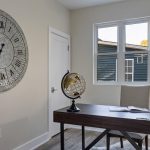When it comes to finding the perfect desk size, it's crucial to start with your workspace dimensions. You'll need to consider factors like room layout, doorways, and windows that could impact your setup. Think about your comfort and how the desk height aligns with your needs. As you assess your requirements, keep in mind the type of work you do and any additional equipment you might need. This will set the foundation for your ideal workspace.
Table of Contents
Key Takeaways
- Measure the length and width of your designated workspace, considering doors and windows for unobstructed placement.
- Determine the appropriate desk height based on your height for optimal comfort and arm positioning.
- Assess the type of work you do to identify the necessary desk space size for your tasks.
- Factor in additional equipment like monitors and accessories to ensure adequate desk surface area.
- Evaluate storage needs to incorporate drawers or shelves that enhance organization and workflow efficiency.
Assess Your Workspace Dimensions
Before you choose your ideal desk size, it's crucial to assess your workspace dimensions. Start by measuring the length and width of the area where you plan to place the desk.
Don't forget to account for any doors, windows, or built-in furniture that could restrict movement or obstruct your desk. Once you have those measurements, visualize how the desk will fit into the space.
Consider leaving some room for additional items, like a chair or filing cabinet, to ensure a comfortable work environment. It's also wise to think about the desk's height and shape, as these factors can influence how well it fits within your designated area.
With accurate measurements, you're one step closer to finding the perfect desk.
Consider Your Height and Comfort
Your height plays a crucial role in determining the right desk size for your workspace. If you're taller, you'll want a desk that allows for comfortable arm positioning without straining your shoulders. A desk height of 29 to 30 inches is generally standard, but you might need something higher.
If you're shorter, consider a desk that's adjustable or one that sits around 25 to 27 inches.
Additionally, think about your chair's height and how it aligns with your desk. Your feet should rest flat on the ground, and your knees should be at a right angle.
Ensuring your desk is at the right height enhances your comfort and productivity, helping you maintain focus during long hours of work.
Determine the Type of Work You Do
Understanding the type of work you do is essential for selecting the right desk size. Different tasks require varying amounts of space. For instance, if you're a writer, you might need just a laptop and some notebooks. However, if you're a graphic designer, you'll need more room for monitors and tools.
Here's a quick overview to help you determine your needs:
| Work Type | Space Needed |
|---|---|
| Writing | Minimal (30" x 20") |
| Graphic Design | Moderate (60" x 30") |
| Project Management | Large (72" x 36") |
Factor in Additional Equipment and Accessories
Once you've determined the type of work you do, it's important to consider any additional equipment and accessories that might occupy your desk space.
These items can greatly influence the size and layout of your ideal desk. Think about what you need to keep within reach for maximum productivity.
Here are some common accessories to factor in:
- A monitor or dual monitors
- A keyboard and mouse
- A desk lamp
- Notebooks or planners
- Charging stations for devices
Evaluate Storage Needs and Functionality
As you assess your ideal desk size, it's crucial to think about your storage needs and how you'll use the space effectively.
Consider what items you need close at hand—documents, stationery, or tech gadgets. If you work with multiple projects, you might need drawers or shelves to keep everything organized.
Think about vertical storage options, like wall-mounted shelves, to maximize your space without cluttering your desk. Also, consider how often you need to access these items; easy-to-reach storage solutions can boost your workflow.
Lastly, ensure your desk has enough surface area for your essential tools while still accommodating any storage you choose. Balance functionality with aesthetics to create an efficient workspace that meets your unique needs.
Frequently Asked Questions
What Materials Are Best for Desk Construction?
When choosing materials for your desk, consider solid wood for durability, metal for a modern look, or laminate for budget-friendly options. Each material offers unique benefits, so pick one that suits your style and needs.
How Can I Personalize My Desk Space?
To personalize your desk space, choose decor that reflects your style, add plants for a touch of nature, and organize essentials in a way that inspires you. Don't forget to include meaningful items that motivate you!
What Are the Benefits of Adjustable Desks?
Adjustable desks offer you flexibility, allowing you to switch between sitting and standing, which can boost your energy and productivity. They also promote better posture and reduce the risk of discomfort from prolonged sitting.
Are There Eco-Friendly Desk Options Available?
Yes, there are plenty of eco-friendly desk options available. You can find desks made from sustainable materials like bamboo or reclaimed wood, and many brands prioritize environmentally conscious manufacturing processes. Your choices can positively impact the planet!
How Do I Maintain My Desk's Longevity?
To maintain your desk's longevity, regularly clean it with gentle products, avoid direct sunlight, and manage humidity. Make sure to secure loose screws and avoid placing heavy objects that could cause damage over time.




